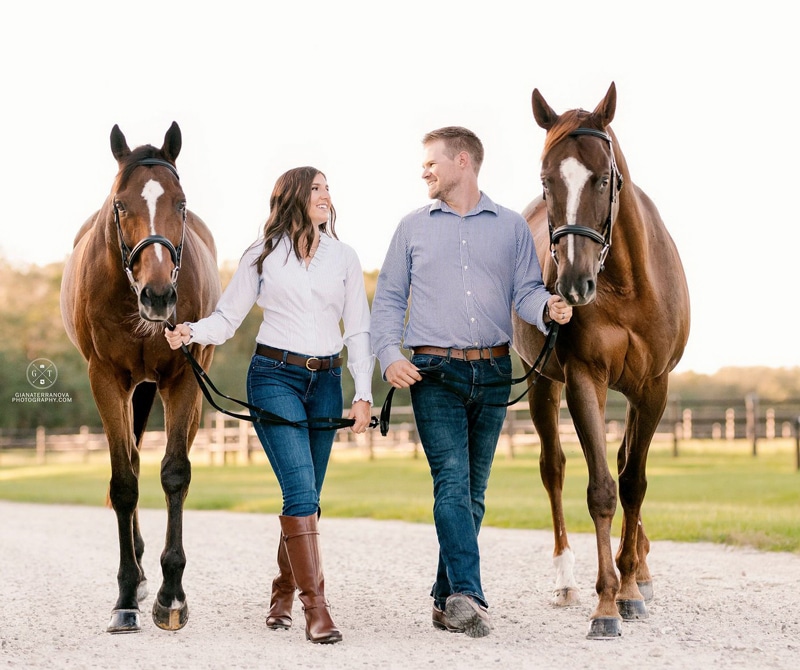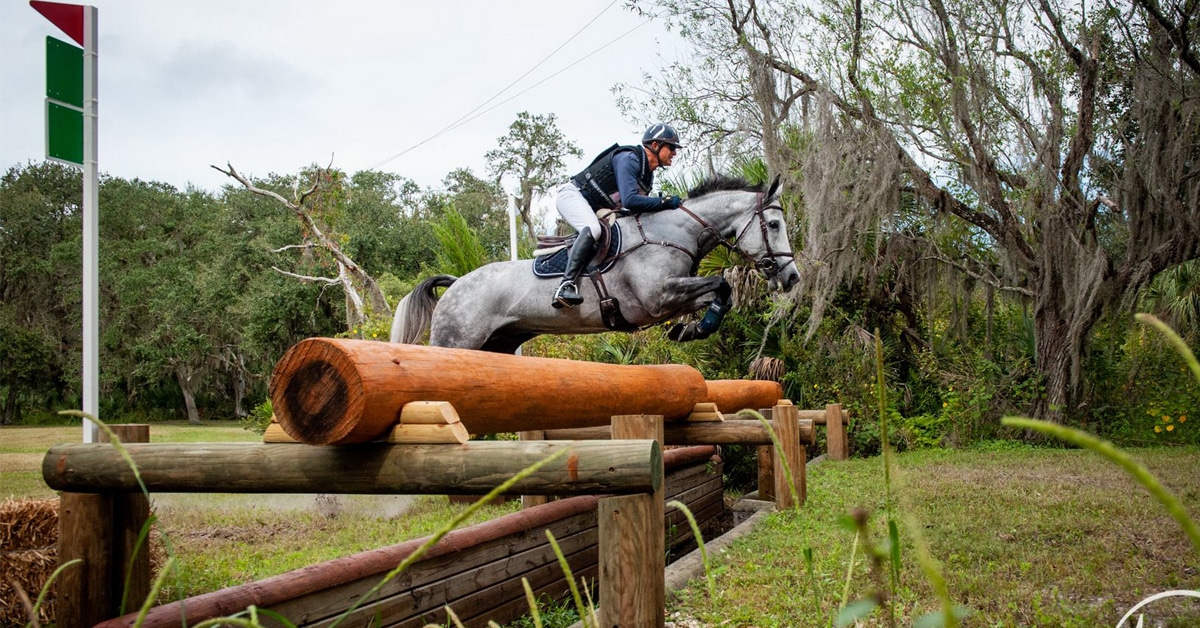TerraNova is Latin for new land; it’s the perfect name for a spectacular equestrian facility that is breaking new ground on the west coast of Florida.
What was once a cow pasture a half-hour’s drive east of enchanting Sarasota on the Gulf of Mexico is now a top-class destination that hit the ground galloping in October with its first eventing competition. The FEI sections were headlined by a prestigious 4-Star Short division, even though the lavish facility in Myakka City never before had run a horse trials at any level.
According to Mike Huber, who chaired the U.S. Equestrian Federation Eventing Sport Committee when a revised eventing calendar was drawn up earlier this year, TerraNova got its dates without a track record because, “They had a proven team that showed they could get things done.”
There was “a lot of stock put into that,” explained Mike, referring to the vastly experienced Mark Phillips being the cross-country course designer and Shelley Howerton Page working as a manager.
In November 2023, TerraNova will start a five-year run granted by USEF for staging a prestigious 4-Star Long. That’s the next-highest level to a 5-star, the ultimate in the sport.

Hannah Herrig Ketelboeter and her husband, Zach, who run the TerraNova Equestrian Center. (Giana Terranova Photography)
Sarasota, known for its beaches, cultural opportunities and shopping, is 150 miles down Interstate 75 from Ocala, where the World Equestrian Center also debuted this year. WEC bought the nearby former Jockey Club property, which had been an eventing site, though no eventing competitions have been allocated there under that ownership.
WEC and TerraNova are both no-expense-spared facilities linked into acreage for high-end housing developments. WEC, believed to carry a pricetag upwards of $500 million, offers restaurants as well as a hotel (another is in the process of being built) in addition to multiple rings and huge indoor arenas. It holds many non-horse offerings, while TerraNova is focused on horses as that venue continues to develop. The equestrian portion of TerraNova is approximately 225 acres, bought for about $2 million. The adjacent 1,000-plus acres, where the housing estates will be built, was purchased for $10.5 million. The outlay for the facilities at the equestrian site is, of course, on top of that spending.
Canadian eventer Kyle Carter salutes TerraNova as “a great example of where a lot of the sports are going to go, where you have super site investment.”
It involves “someone coming in tailoring a facility to generate maximum exposure and opportunity in the sport. Yes, it’s an enormous investment, but there is huge opportunity to create Disneyland-like experiences in their sites. What it will do is create a major international opportunity for everybody who wishes to take advantage of it.”
TerraNova is a project of the Herrig family. Entrepreneur Steve Herrig, who is in workers’ compensation insurance, among other businesses, has put the equestrian portion of the property under the guidance of his daughter, Hannah. She also has involvement on the housing side. Steve is there to offer advice and business acumen as needed, but Hannah, a 26-year-old University of Florida graduate with a degree in communications and leadership fulfillment (her minor was wildlife conservation and ecology) brings a fresh perspective to the project.
“Experience keeps me from doing the wrong things, but inexperience keeps me from doing the same thing,” she noted cheerfully.
Hannah, who has ridden all her life, works with her husband, Zach Ketelboeter, who is in charge of operations. He has a background in construction and stable management that makes him the “go-to guy” on the property. The couple named the venue, which includes an impressive training stable, after two of their horses, Terra and Nova. Hannah’s mother, Natalee, also is busy with the venture, working on its charitable aspects and leading the community outreach effort.
“The more that we put into it, the bigger it seems to become,” said Natalee.
“There’s a vision and a dream, but we’re really surprised ourselves at how beautiful it is and how well it’s received, so we’re very grateful for that. It’s a more natural venue, kind of hearkening back to a time when people can be outside, (with) not a lot of technology, not a lot of concrete, mostly just appreciating nature and the animal world.”
Noting the location is equidistant from Wellington and Ocala, Hannah pointed out that the Sarasota area has been “a bit underserved” in terms of equestrian opportunities, especially for dressage and eventing. She wants to keep a natural, open feel to TerraNova in order for the horses to experience a more relaxed atmosphere than what they encounter at some of the more crowded venues.
That will remain the philosophy as work continues on the property, which eventually will have 600 permanent stalls, a viewing building with a restaurant for the main arena and a clubhouse located on the housing estates side.
Sarasota’s top-class restaurants and hotels are reasonably close, as is the expanding Lakewood Ranch residential community development.
“It’s really the best of both worlds, in that you can have this rural country feel and you don’t have to drive too far and you can have any kind of urban experience you want,” observed Hannah.
She rode up to the Preliminary level in eventing, but made the switch to dressage six months ago with an eye toward competing in freestyles. Although TerraNova took its first public bow with eventing, hunter/jumper competitions are already set, and dressage and driving are waiting in the wings. Hannah and her family have the overall vision of what will happen, but specialists are brought in to help run each discipline.
Eventer Sarah Kozumplik-Murphy, who has acted as a rider liaison, assisted in finding the right people for the many roles needed to run a successful venture.
“I knew who to call,” she said. That included safety expert Rusty Lowe, who consulted on where road access was needed and on training for medical teams in the area to deal with horse sport mishaps. She also recommended Mark Phillips, with Eric Bull to build the cross-country jumps.
Sara said the Kentucky Horse Park was part of the inspiration for TerraNova, though Myakka is a flat area without the hills that are a feature of Kentucky’s testing terrain. Like Kentucky, though, there are places for competitors to hack and graze their horses. Comparing the atmosphere to what may be encountered at other showgrounds, she characterized it as “a little more chilled out.”
“We don’t want to be a 3,000-horse show. We want a chic country-feel facility that is high in customer service and horses-come-first driven.”
Sara understands the Herrig family’s vision. “They’re trying to make everything really easy, whether you’re a groom, an owner or a spectator; they’re trying to do something the entire community can enjoy, whether you ride horses or you don’t, and something that can give back to the community as well. Their hospitality is out of this world.”
For show jumping, the specialist is Mike Belisle, a Canadian who has worked at the Winter Equestrian Festival and many other venues. His consulting firm, Helm Limited, has also been involved with the Split Rock show jumping tour, which will hold its Sarasota CSI 2-Star show at TerraNova Jan. 26-30, 2022.
Explaining his decision to become involved with TerraNova, he said, “I really believed in their vision and them as people and business owners.”
Prior to becoming involved with TerraNova, he wasn’t familiar with the Sarasota area. He realized after looking into it “how much horse power is there and how much horse community is there.”
Mike mentioned James and Misdee Wrigley Miller’s polo club and the Fox Lea Farm horse show venue in Venice, south of the city. At the same time, he saw room for TerraNova on the calendar. “I think we will carve out a niche in the Florida market,” said Mike.
The facility’s features and multi-discipline approach prompt one to ask whether it might be a likely candidate for an FEI World Equestrian Games venue.
“We would definitely entertain that opportunity,” he responded, while cautioning it is still early days and “I want to crawl before we walk. Let’s see what we have. We’re in it for the long haul.”
Mike added, “We don’t want to be a 3,000-horse show. We want a chic country-feel facility that is high in customer service and horses-come-first driven.”
At the same time, he said, TerraNova will cater to all levels. Hannah and Zach haven’t forgotten the base of the sport while working to attract elite riders.
“We had an awards ceremony and prize money for every level, we had a live stream that covered every level. We tried to make sure that our lower-level competitors got the same quality experience as our upper-level riders” Hannah said.
Care is taken with every detail.
“It’s very impressive. They are trying to do all the right things. There are a few little growing pains, but for the first year, they did a great job,” said Canadian eventer Karl Slezak who finished second in the Open Novice, noting that TerraNova is a nice option within easy driving distance of his Ocala base.
Pointing out that TerraNova ran irrigation lines through the site, along with other amenities, Kyle commented, “That sort of effort is unheard of in our sport.”
Eventing has been inclined in the past toward an approach of “you just kind of deal with it,” he noted. “I think that’s fair enough in our traditional concept of what our sport is, it’s about dealing with things in the countryside that are around us.”
However, he added, “When you think of the expense of these horses when they’re getting to the top level, what they’re worth now, you can no longer just sort of say, `Well, that’s our sport.’ I think you kind of have to look at it the way TerraNova did and say, `This is our new type of sport and we’re going to do our best to make this happen at a high level,’ so it’s worth taking a horse there and running them.”
The TerraNova crew went out on the Monday after their event, aerated parts of the course, and sent videos of horses galloping over it to Kyle and other professionals who had given them feedback about the competion in terms of what could be improved.
Kyle, who said the footing was a bit hard during the competition, explained those watching the post-event videos could see how deep the horses’ hooves were cutting into the grass after the surface was aerated. Kyle believes that if the hooves are cutting 1½ inches into the footing, then it is absorbing concussion on the joints, which makes it better footing to run on.
“They’re full-on invested,” said Kyle. “The continual improvement is going to make the difference and they are committed to it.”

